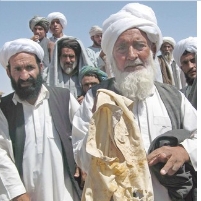U.S. Killing of Civilians Blamed on Ignorance of Afghan Society…After 8 Years
Thursday, April 15, 2010
 Afghan Man Holds Shirt of a Child Killed by a U.S. Airstrike in western Herat province (photo: Jalil Rezayee, EPA)
Afghan Man Holds Shirt of a Child Killed by a U.S. Airstrike in western Herat province (photo: Jalil Rezayee, EPA)
There is much the U.S. military and intelligence community don’t know about Afghanistan’s politics and culture, resulting in decisions that are born of ignorance and the product of suspect information from local sources with personal agendas. Because commanders and their key subordinates don’t have firsthand knowledge of, say, the country’s important and complex tribal system, they have to rely on informants or tribal warlords for intelligence, and in doing so have sent troops into situations that have produced terrible results.
On February 12, Special Operations soldiers attacked a village, killing three women and two Afghan government officials. The target was chosen because of what the military had been told by an informant. A local council member said American Special Forces “don’t know who is the enemy and who isn’t.”
Likewise, the United States’ top military intelligence officer in Afghanistan, General Michael Flynn, was quoted in a report by the Center for a New American Security saying: “I don’t want to say we’re clueless, but we are. We’re no more than fingernail deep in our understanding the environment.”
Another case in point is the Korengal Valley. In 2005, the U.S. sent in troops to the region thinking the move would draw insurgents away from other parts of Afghanistan. What American soldiers got was constant assaults that left 40 U.S. dead and many more wounded. It took five years before commanders “concluded that the U.S. had blundered into a blood feud with fierce and clannish villagers who wanted above all to be left alone,” according to The Washington Post.
-Noel Brinkerhoff
U.S.: Ignorance of Afghan Society Led to Botched Raids (by Gareth Porter, Inter Press Service)
U.S. Forces Leave Afghanistan's Korengal Valley (by Greg Jaffe, Washington Post)
NATO Admits U.S. Forces Killed Innocent Pregnant Women in Afghanistan (by Noel Brinkerhoff, AllGov)
Voices from the Field (Center for a New American Security) (pdf)
- Top Stories
- Unusual News
- Where is the Money Going?
- Controversies
- U.S. and the World
- Appointments and Resignations
- Latest News
- Trump to Stop Deportations If…
- Trump Denounces World Series
- What If China Invaded the United States?
- Donald Trump Has a Mental Health Problem and It Has a Name
- Trump Goes on Renaming Frenzy






Comments